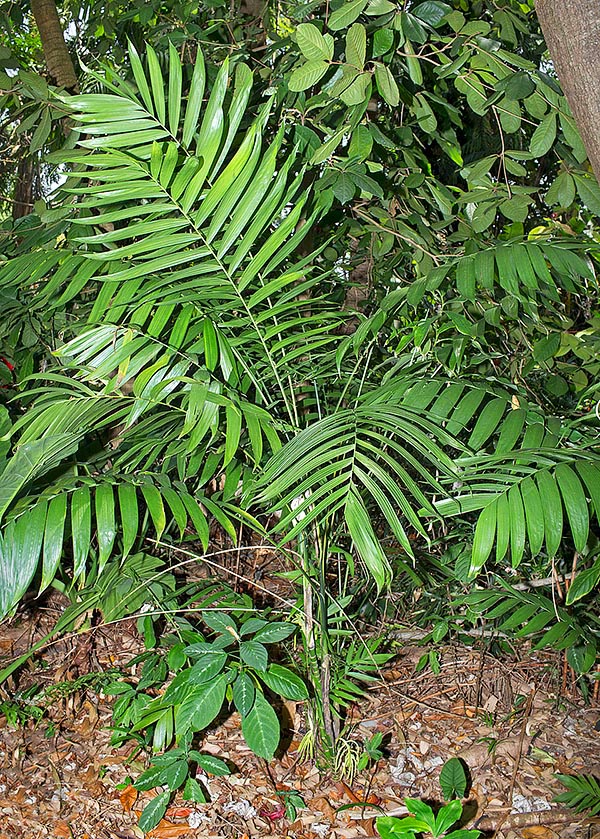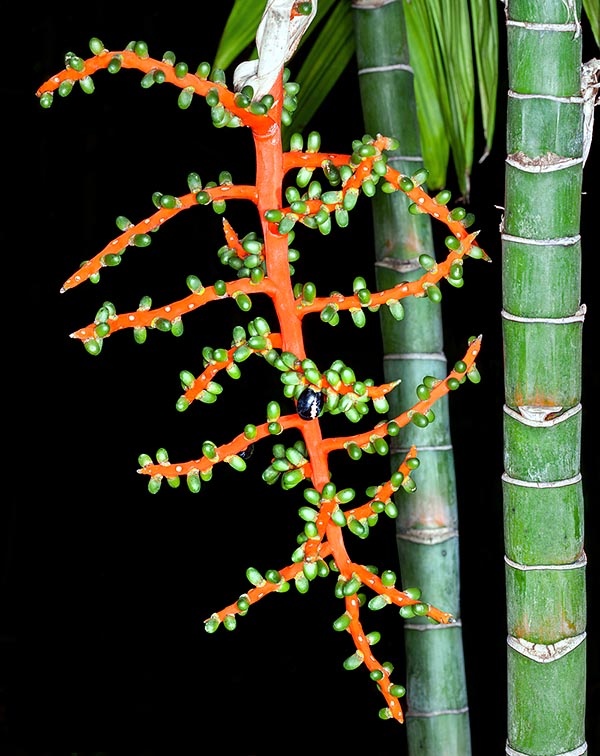Family : Arecaceae

Text © Pietro Puccio

English translation by Mario Beltramini

The Central America Chamadorea tepejilote, exceeds, with cespitose or solitary stems, the 5 m of height © Giuseppe Mazza
The name of the genus is the combination of the Greek adverb “χαμαί” (chamai) = on the ground, on the soil, and of the substantive “δωρέα” (doréa) = gift, the German botanist Carl Ludwig Willdenow (1765-1812), who has established the genus in 1806, did not specify the exact meaning of the name. The specific name comes from one of the local names in the Nauhatl language meaning “mountain ear”, due to the resemblance to the immature, edible, male inflorescences, to the corn ear.
Common names: pacaya palm (English); khíb shul, pacaya (Belize); pacaya, palmito dulce (Costa Rica); pacaya (El Salvador); pacaya, tepejilote, caña verde, guaya, ixquil (Guatemala and Mexico); bodá, bolá, caña agria, caña verde, nurú, pacaya (Panama).
The Chamaedorea tepejilote Liebm. (1849) is a rather variable dioecious species with solitary stems, rarely caespitose, usually erect, often with adventitious roots at the base, 2-5(-7) m tall and of 2-8 cm of diameter, of green colour with the rings trace of the fallen leaves, spaced 2-12 cm, prominent.
Pinnate, 0,6-1,8 m long, leaves, on a 15-30 cm long petiole, arcuate, of green colour with a yellow cream band below that prolongs all over the rachis. Foliar lamina with 6-20 leaflets per side arranged regularly along the rachis, more or less alternate, linear lanceolate to sigmoid, thinned at the apex and at the base, 16-60 cm long and 3-8 cm broad, of glossy intense green colour.
The tubular foliar base, of pale green colour, obliquely open at the apex, wraps wholly the stem for a length of 20-30 cm, persisting dry for long time. Inflorescences under the leaves (infrafoliar), enclosed initially in 4-5 bracts, erect and long pointed, 30-60 cm long, ramified. Male inflorescences with numerous rachillae, 6-15 cm long, drooping, of greenish yellow colour, bearing numerous close flowers of yellow colour, fragrant, about 2 mm long and of 4 mm of diamleter, with 6 stamina.
Female inflorescences with fewer rachillae, up to 30 cm long, of greenish yellow colour, then orange red when in fruit, flowers similar to the male ones, but more spaced, with prominent stigmata.

The female inflorescences, before greenish yellow then orange red, reach the 30 cm with green fruits, 1,2-1,6 cm long, that then turn glossy black when ripe. The immature male inflorescences are edible © Giuseppe Mazza
It reproduces by seed in draining loam maintained humid at the temperature of 24-26 °C, with germination times starting from 2-3 months; the caespitose shape may be reproduced by division.
Among the largest of the genus, is cultivated since remote times due to the immature edible male inflorescences, collected when still enclosed in the bracts, consumed cooked as vegetables or raw in salads.
Of considerable ornamental value due to the elegantly arcuate leaves and the slightly drooping leaflets, in particular the female specimens when fruiting, is frequently employed solitary or in group in the tropical and subtropical gardens, its cultivation may be tried in the milder warm temperate climate zones, where it can stand temperatures around the 0 °C, only if exceptional and very short lasting.
It requires a slight shade and is not particular about the soil, provided draining and maintained constantly humid, even if well rooted it can bear short dry periods. Useful are the fertilizations employing preferably slow release products. Excellent subject to be cultivated in pot, for the decoration of outer spaces and luminous and spacious inner ones.
When indoors it may be subject attacks of pests, such as mites and scale insects, consequently is to be kept under control in order to be able to promptly take action with specific products.
Synonyms: Chamaedorea casperiana Klotzsch (1852); Chamaedorea wendlandiana (Oerst.) Hemsl. (1855); Stephanostachys casperiana (Klotzsch) Oerst. (1859); Stephanostachys tepejilote (Liebm.) Oerst. (1658); Stephanostachys wendlandiana Oerst. (1859); Chamaedorea wendlandiana (Oerst.) H. Wendl. (1878); Nunnezharia casperiana (Klotzsch) Kuntze (1891); Nunnezharia tepejilote (Liebm.) Kuntze (1891); Nunnezharia wendlandiana (Oerst.) Kuntze (1891); Chamaedorea exorrhiza H.Wendl. ex Guillaumin (1922); Chamaedorea exorrhiza H.Wendl. ex Guillaumin (1922); Chamaedorea anomospadix Burret (1933); Chamaedorea sphaerocarpa Burret (1933); Chamaedorea columbica Burret (1934); Edanthe veraepacis O.F.Cook (1939).
→ For general notions about ARECACEAE please click here.
